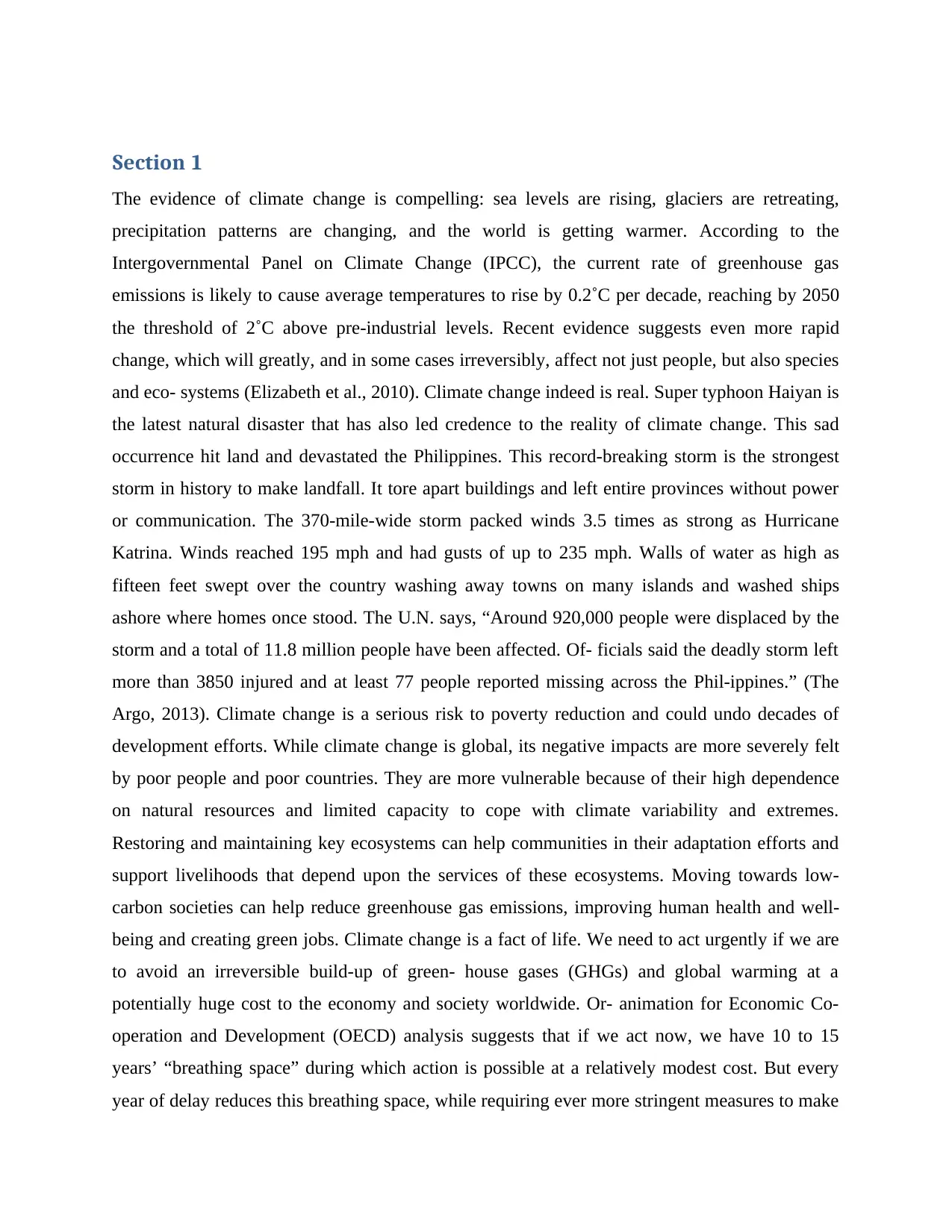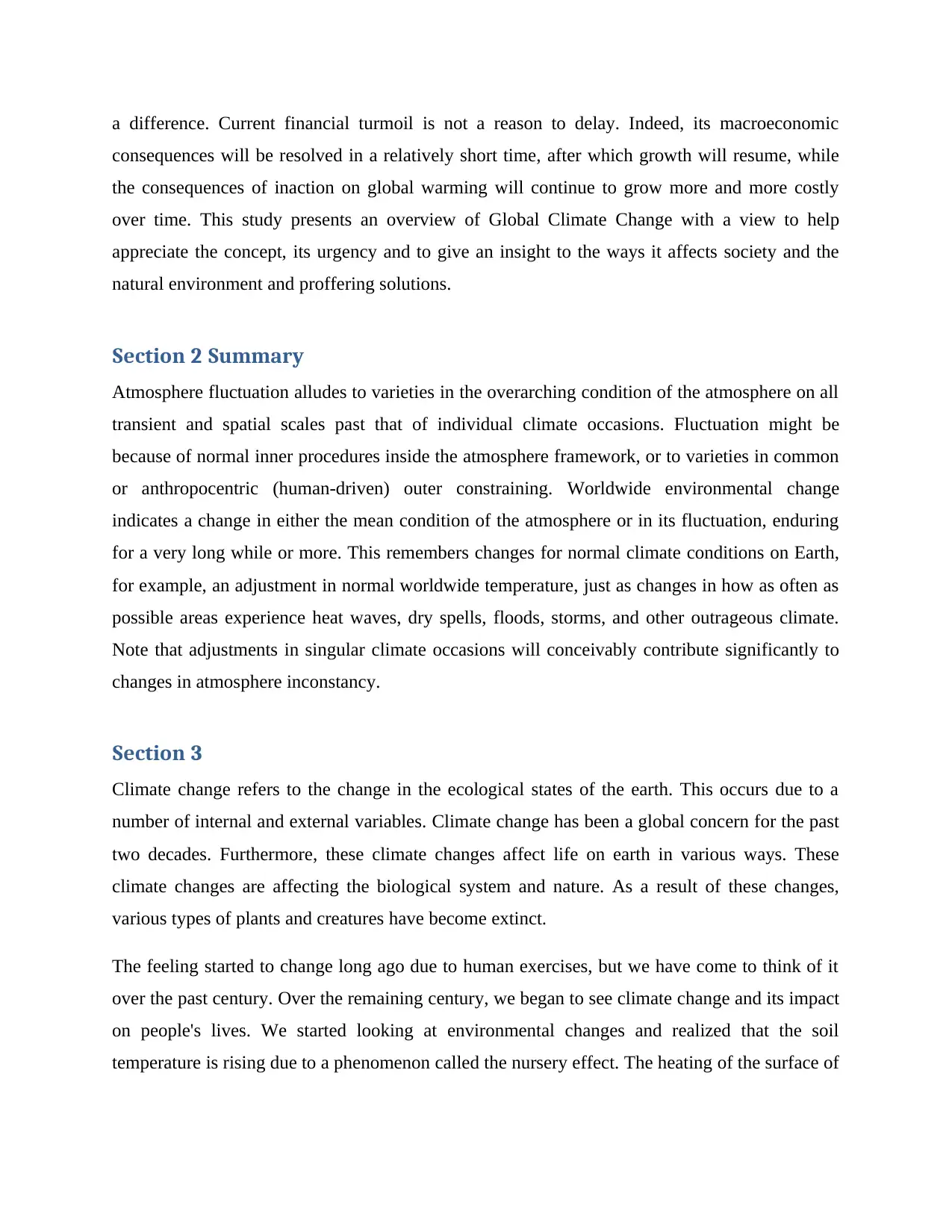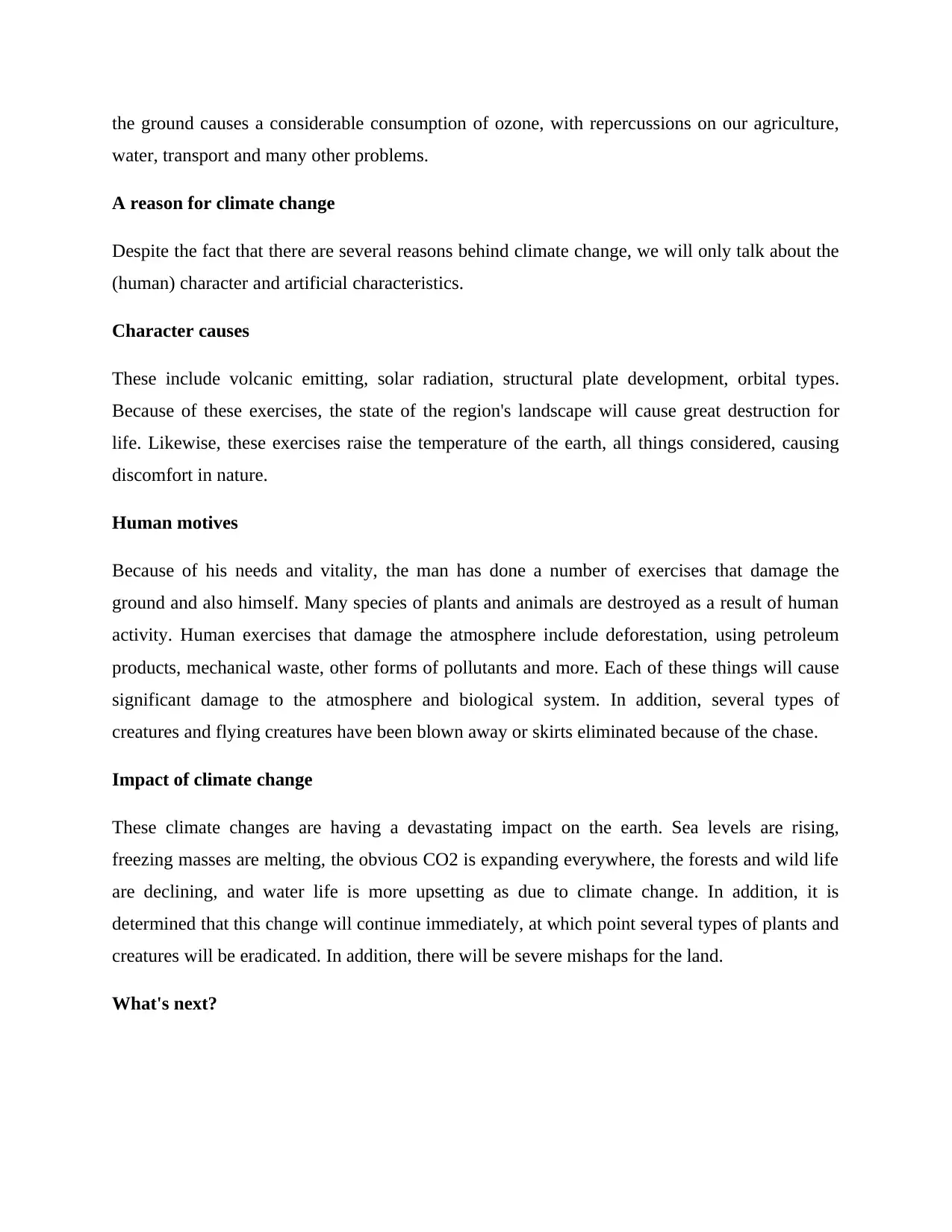An Analysis of Global Climate Change: Essay on Impacts
VerifiedAdded on 2023/01/11
|5
|1310
|31
Essay
AI Summary
This essay delves into the compelling evidence of climate change, highlighting rising sea levels, retreating glaciers, and altered precipitation patterns. It references the IPCC's projections, emphasizing the urgency of addressing greenhouse gas emissions. The essay uses Super Typhoon Haiyan as a case study, illustrating the devastating consequences of climate change and its disproportionate impact on vulnerable populations. It explores both natural and human-driven causes, including volcanic emissions and deforestation, while also discussing the adverse effects on ecosystems and biodiversity. The essay underscores the need for urgent action, proposing solutions like moving towards low-carbon societies and ecosystem restoration, and concluding with a call to action to prevent irreversible damage and safeguard the future.

Academic English
Skills
Skills
Paraphrase This Document
Need a fresh take? Get an instant paraphrase of this document with our AI Paraphraser

Section 1
The evidence of climate change is compelling: sea levels are rising, glaciers are retreating,
precipitation patterns are changing, and the world is getting warmer. According to the
Intergovernmental Panel on Climate Change (IPCC), the current rate of greenhouse gas
emissions is likely to cause average temperatures to rise by 0.2˚C per decade, reaching by 2050
the threshold of 2˚C above pre-industrial levels. Recent evidence suggests even more rapid
change, which will greatly, and in some cases irreversibly, affect not just people, but also species
and eco- systems (Elizabeth et al., 2010). Climate change indeed is real. Super typhoon Haiyan is
the latest natural disaster that has also led credence to the reality of climate change. This sad
occurrence hit land and devastated the Philippines. This record-breaking storm is the strongest
storm in history to make landfall. It tore apart buildings and left entire provinces without power
or communication. The 370-mile-wide storm packed winds 3.5 times as strong as Hurricane
Katrina. Winds reached 195 mph and had gusts of up to 235 mph. Walls of water as high as
fifteen feet swept over the country washing away towns on many islands and washed ships
ashore where homes once stood. The U.N. says, “Around 920,000 people were displaced by the
storm and a total of 11.8 million people have been affected. Of- ficials said the deadly storm left
more than 3850 injured and at least 77 people reported missing across the Phil-ippines.” (The
Argo, 2013). Climate change is a serious risk to poverty reduction and could undo decades of
development efforts. While climate change is global, its negative impacts are more severely felt
by poor people and poor countries. They are more vulnerable because of their high dependence
on natural resources and limited capacity to cope with climate variability and extremes.
Restoring and maintaining key ecosystems can help communities in their adaptation efforts and
support livelihoods that depend upon the services of these ecosystems. Moving towards low-
carbon societies can help reduce greenhouse gas emissions, improving human health and well-
being and creating green jobs. Climate change is a fact of life. We need to act urgently if we are
to avoid an irreversible build-up of green- house gases (GHGs) and global warming at a
potentially huge cost to the economy and society worldwide. Or- animation for Economic Co-
operation and Development (OECD) analysis suggests that if we act now, we have 10 to 15
years’ “breathing space” during which action is possible at a relatively modest cost. But every
year of delay reduces this breathing space, while requiring ever more stringent measures to make
The evidence of climate change is compelling: sea levels are rising, glaciers are retreating,
precipitation patterns are changing, and the world is getting warmer. According to the
Intergovernmental Panel on Climate Change (IPCC), the current rate of greenhouse gas
emissions is likely to cause average temperatures to rise by 0.2˚C per decade, reaching by 2050
the threshold of 2˚C above pre-industrial levels. Recent evidence suggests even more rapid
change, which will greatly, and in some cases irreversibly, affect not just people, but also species
and eco- systems (Elizabeth et al., 2010). Climate change indeed is real. Super typhoon Haiyan is
the latest natural disaster that has also led credence to the reality of climate change. This sad
occurrence hit land and devastated the Philippines. This record-breaking storm is the strongest
storm in history to make landfall. It tore apart buildings and left entire provinces without power
or communication. The 370-mile-wide storm packed winds 3.5 times as strong as Hurricane
Katrina. Winds reached 195 mph and had gusts of up to 235 mph. Walls of water as high as
fifteen feet swept over the country washing away towns on many islands and washed ships
ashore where homes once stood. The U.N. says, “Around 920,000 people were displaced by the
storm and a total of 11.8 million people have been affected. Of- ficials said the deadly storm left
more than 3850 injured and at least 77 people reported missing across the Phil-ippines.” (The
Argo, 2013). Climate change is a serious risk to poverty reduction and could undo decades of
development efforts. While climate change is global, its negative impacts are more severely felt
by poor people and poor countries. They are more vulnerable because of their high dependence
on natural resources and limited capacity to cope with climate variability and extremes.
Restoring and maintaining key ecosystems can help communities in their adaptation efforts and
support livelihoods that depend upon the services of these ecosystems. Moving towards low-
carbon societies can help reduce greenhouse gas emissions, improving human health and well-
being and creating green jobs. Climate change is a fact of life. We need to act urgently if we are
to avoid an irreversible build-up of green- house gases (GHGs) and global warming at a
potentially huge cost to the economy and society worldwide. Or- animation for Economic Co-
operation and Development (OECD) analysis suggests that if we act now, we have 10 to 15
years’ “breathing space” during which action is possible at a relatively modest cost. But every
year of delay reduces this breathing space, while requiring ever more stringent measures to make

a difference. Current financial turmoil is not a reason to delay. Indeed, its macroeconomic
consequences will be resolved in a relatively short time, after which growth will resume, while
the consequences of inaction on global warming will continue to grow more and more costly
over time. This study presents an overview of Global Climate Change with a view to help
appreciate the concept, its urgency and to give an insight to the ways it affects society and the
natural environment and proffering solutions.
Section 2 Summary
Atmosphere fluctuation alludes to varieties in the overarching condition of the atmosphere on all
transient and spatial scales past that of individual climate occasions. Fluctuation might be
because of normal inner procedures inside the atmosphere framework, or to varieties in common
or anthropocentric (human-driven) outer constraining. Worldwide environmental change
indicates a change in either the mean condition of the atmosphere or in its fluctuation, enduring
for a very long while or more. This remembers changes for normal climate conditions on Earth,
for example, an adjustment in normal worldwide temperature, just as changes in how as often as
possible areas experience heat waves, dry spells, floods, storms, and other outrageous climate.
Note that adjustments in singular climate occasions will conceivably contribute significantly to
changes in atmosphere inconstancy.
Section 3
Climate change refers to the change in the ecological states of the earth. This occurs due to a
number of internal and external variables. Climate change has been a global concern for the past
two decades. Furthermore, these climate changes affect life on earth in various ways. These
climate changes are affecting the biological system and nature. As a result of these changes,
various types of plants and creatures have become extinct.
The feeling started to change long ago due to human exercises, but we have come to think of it
over the past century. Over the remaining century, we began to see climate change and its impact
on people's lives. We started looking at environmental changes and realized that the soil
temperature is rising due to a phenomenon called the nursery effect. The heating of the surface of
consequences will be resolved in a relatively short time, after which growth will resume, while
the consequences of inaction on global warming will continue to grow more and more costly
over time. This study presents an overview of Global Climate Change with a view to help
appreciate the concept, its urgency and to give an insight to the ways it affects society and the
natural environment and proffering solutions.
Section 2 Summary
Atmosphere fluctuation alludes to varieties in the overarching condition of the atmosphere on all
transient and spatial scales past that of individual climate occasions. Fluctuation might be
because of normal inner procedures inside the atmosphere framework, or to varieties in common
or anthropocentric (human-driven) outer constraining. Worldwide environmental change
indicates a change in either the mean condition of the atmosphere or in its fluctuation, enduring
for a very long while or more. This remembers changes for normal climate conditions on Earth,
for example, an adjustment in normal worldwide temperature, just as changes in how as often as
possible areas experience heat waves, dry spells, floods, storms, and other outrageous climate.
Note that adjustments in singular climate occasions will conceivably contribute significantly to
changes in atmosphere inconstancy.
Section 3
Climate change refers to the change in the ecological states of the earth. This occurs due to a
number of internal and external variables. Climate change has been a global concern for the past
two decades. Furthermore, these climate changes affect life on earth in various ways. These
climate changes are affecting the biological system and nature. As a result of these changes,
various types of plants and creatures have become extinct.
The feeling started to change long ago due to human exercises, but we have come to think of it
over the past century. Over the remaining century, we began to see climate change and its impact
on people's lives. We started looking at environmental changes and realized that the soil
temperature is rising due to a phenomenon called the nursery effect. The heating of the surface of
⊘ This is a preview!⊘
Do you want full access?
Subscribe today to unlock all pages.

Trusted by 1+ million students worldwide

the ground causes a considerable consumption of ozone, with repercussions on our agriculture,
water, transport and many other problems.
A reason for climate change
Despite the fact that there are several reasons behind climate change, we will only talk about the
(human) character and artificial characteristics.
Character causes
These include volcanic emitting, solar radiation, structural plate development, orbital types.
Because of these exercises, the state of the region's landscape will cause great destruction for
life. Likewise, these exercises raise the temperature of the earth, all things considered, causing
discomfort in nature.
Human motives
Because of his needs and vitality, the man has done a number of exercises that damage the
ground and also himself. Many species of plants and animals are destroyed as a result of human
activity. Human exercises that damage the atmosphere include deforestation, using petroleum
products, mechanical waste, other forms of pollutants and more. Each of these things will cause
significant damage to the atmosphere and biological system. In addition, several types of
creatures and flying creatures have been blown away or skirts eliminated because of the chase.
Impact of climate change
These climate changes are having a devastating impact on the earth. Sea levels are rising,
freezing masses are melting, the obvious CO2 is expanding everywhere, the forests and wild life
are declining, and water life is more upsetting as due to climate change. In addition, it is
determined that this change will continue immediately, at which point several types of plants and
creatures will be eradicated. In addition, there will be severe mishaps for the land.
What's next?
water, transport and many other problems.
A reason for climate change
Despite the fact that there are several reasons behind climate change, we will only talk about the
(human) character and artificial characteristics.
Character causes
These include volcanic emitting, solar radiation, structural plate development, orbital types.
Because of these exercises, the state of the region's landscape will cause great destruction for
life. Likewise, these exercises raise the temperature of the earth, all things considered, causing
discomfort in nature.
Human motives
Because of his needs and vitality, the man has done a number of exercises that damage the
ground and also himself. Many species of plants and animals are destroyed as a result of human
activity. Human exercises that damage the atmosphere include deforestation, using petroleum
products, mechanical waste, other forms of pollutants and more. Each of these things will cause
significant damage to the atmosphere and biological system. In addition, several types of
creatures and flying creatures have been blown away or skirts eliminated because of the chase.
Impact of climate change
These climate changes are having a devastating impact on the earth. Sea levels are rising,
freezing masses are melting, the obvious CO2 is expanding everywhere, the forests and wild life
are declining, and water life is more upsetting as due to climate change. In addition, it is
determined that this change will continue immediately, at which point several types of plants and
creatures will be eradicated. In addition, there will be severe mishaps for the land.
What's next?
Paraphrase This Document
Need a fresh take? Get an instant paraphrase of this document with our AI Paraphraser

Just in case we do nothing and things will continue as they are now, every day will come in the
future when people are swept away from outside the earth. Be that as it may, instead of avoiding
those problems that we begin to pursue, we can save our land and our future.
I am agreed with the writer upon this topic; as mentioned by author that the major impact on
climate is due to increasing in CO2 gas coming from transport factories and other sources. This
impact seems to be continue in future if not found any perfect alternative to reduce this;
otherwise this situation is growing in the field where its affect s irreversible.
future when people are swept away from outside the earth. Be that as it may, instead of avoiding
those problems that we begin to pursue, we can save our land and our future.
I am agreed with the writer upon this topic; as mentioned by author that the major impact on
climate is due to increasing in CO2 gas coming from transport factories and other sources. This
impact seems to be continue in future if not found any perfect alternative to reduce this;
otherwise this situation is growing in the field where its affect s irreversible.
1 out of 5
Related Documents
Your All-in-One AI-Powered Toolkit for Academic Success.
+13062052269
info@desklib.com
Available 24*7 on WhatsApp / Email
![[object Object]](/_next/static/media/star-bottom.7253800d.svg)
Unlock your academic potential
Copyright © 2020–2025 A2Z Services. All Rights Reserved. Developed and managed by ZUCOL.





